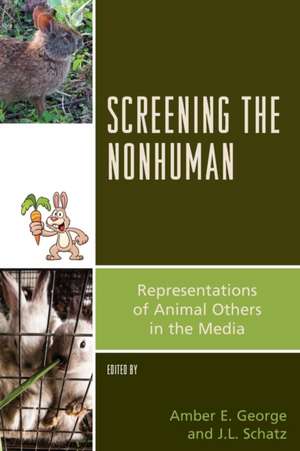Screening the Nonhuman: Critical Animal Studies and Theory
en Limba Engleză Paperback – 5 noi 2018
| Toate formatele și edițiile | Preț | Express |
|---|---|---|
| Paperback (1) | 396.52 lei 6-8 săpt. | |
| Rowman & Littlefield – 5 noi 2018 | 396.52 lei 6-8 săpt. | |
| Hardback (1) | 681.83 lei 6-8 săpt. | |
| Rowman & Littlefield – 27 apr 2016 | 681.83 lei 6-8 săpt. |
Preț: 396.52 lei
Nou
Puncte Express: 595
Preț estimativ în valută:
75.88€ • 81.14$ • 63.26£
75.88€ • 81.14$ • 63.26£
Carte tipărită la comandă
Livrare economică 17 aprilie-01 mai
Preluare comenzi: 021 569.72.76
Specificații
ISBN-13: 9781498513760
ISBN-10: 149851376X
Pagini: 240
Dimensiuni: 152 x 229 x 18 mm
Greutate: 0.35 kg
Editura: Rowman & Littlefield
Seria Critical Animal Studies and Theory
ISBN-10: 149851376X
Pagini: 240
Dimensiuni: 152 x 229 x 18 mm
Greutate: 0.35 kg
Editura: Rowman & Littlefield
Seria Critical Animal Studies and Theory
Notă biografică
Amber E. George is program coordinator for the Intergroup Dialogue Project at Cornell University.
J.L. Schatz is instructor at Binghamton University.
Cuprins
Introduction: Critical Media Studies and Critical Animal Studies at the Crossroads, Amber George and J.L. Schatz
Part I
Chapter One: The Brown Wizard¿s Unexpected Politics: Speciesist Fiction and the Ethics of The Hobbit, J.L. Schatz
Chapter Two: The Passing Faerie and the Transforming Raven: Animalized Compulsory Re-covery, Endurance, and Dis/ability in Maleficent, Jennifer Polish
Chapter Three: Jabbering Jaws: Reimagining Representations of Sharks Post-Jaws, Matthew Lerberg
Chapter Four: Horseplay: Beastly Cinematic Performances in Steven Spielberg¿s War Horse, Stella Hockenhull
Chapter Five: Would Bugs Bunny Have Diabetes?: The Realistic Consequences of Cartoons for Non/Human Animals, Amber E. George
Part II
Chapter Six: I Am Legend (2007), U.S. Imperialism, and the Liminal Animality of ¿The Last Man, Carter Soles
Chapter Seven: Ape Anxiety: Intelligence, Human Supremacy, and Rise and Dawn of the Planet of the Apes, Sean Parson
Chapter Eight: The Vicious Cycle of Disnification and Audience Demands: Representations of the Non/Human in Martin Rosen¿s Watership Down (1978) and The Plague Dogs (1982), Anja Höing & Harald Husemann
Chapter Nine: The ¿Nature-Run-Amok¿ Cinema of the 1970s: Representation of Non/human Animals in Frogs and Orca, Fernando Gabriel Pagnoni Berns and César Alfonso Marino
Part III
Chapter Ten: Cyberbeasts: Substitution and Trivialization of the Non/Human Animal in Home Movies, Memes, and Video Games, Joseph Anderton
Chapter Eleven: Pet-Animals in the Concrete Jungle: Tales of Abandonment, Failures, and Sentimentality in San Hua and Twelve Nights, Fiona Yuk-wa Law
Chapter Twelve: In Defense of Non/Humans: Mystification and Oppression in the Sports Mascoting Process, Guilherme Nothen and Michael Atkinson
Chapter Thirteen: On Empathy, Anthropocentrism, and Rhetorical Tropes: An Analysis of Online ¿Save the Bees!¿ Campaign Images, Christina Victoria Cedillo
Descriere
This collection draws connections between the ways in which animals represented on screen translate into reality. In doing so, it demonstrates that media consumption is not a neutral act but, rather, a political one. The images humans consume have real-world consequences for how animals are treated as actors, as pets, and in nature.





